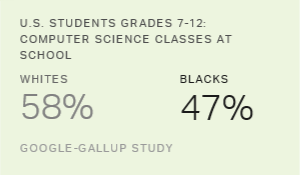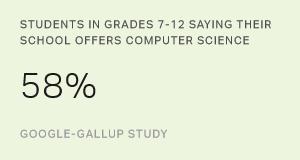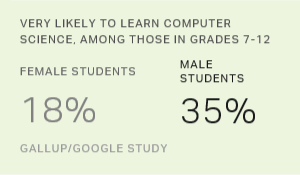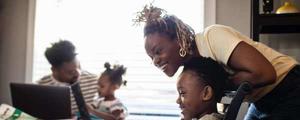Story Highlights
- Black students are less likely than white students to have access to classes
- Fewer blacks and Hispanics than whites frequently use a computer at home
- Black students more likely to see computer science in TV shows, movies
WASHINGTON, D.C. -- Black students are less likely than white and Hispanic students in grades seven through 12 in the U.S. to be exposed to computer science learning at school, according to a new study conducted by Gallup and Google. Specifically, black students are less likely than white and Hispanic students to say their school offers classes dedicated to computer science. Black students are also less likely to say computer science is taught as part of other classes at their school.
| Whites | Blacks | Hispanics | |||||||||||||||||||||||||||||||||||||||||||||||||||||||||||||||||||||||||||||||||||||||||||||||||
|---|---|---|---|---|---|---|---|---|---|---|---|---|---|---|---|---|---|---|---|---|---|---|---|---|---|---|---|---|---|---|---|---|---|---|---|---|---|---|---|---|---|---|---|---|---|---|---|---|---|---|---|---|---|---|---|---|---|---|---|---|---|---|---|---|---|---|---|---|---|---|---|---|---|---|---|---|---|---|---|---|---|---|---|---|---|---|---|---|---|---|---|---|---|---|---|---|---|---|---|
| % | % | % | |||||||||||||||||||||||||||||||||||||||||||||||||||||||||||||||||||||||||||||||||||||||||||||||||
| Classes where only computer science is taught | 58 | 47 | 59 | ||||||||||||||||||||||||||||||||||||||||||||||||||||||||||||||||||||||||||||||||||||||||||||||||
| Computer science taught as part of other classes | 53 | 44 | 56 | ||||||||||||||||||||||||||||||||||||||||||||||||||||||||||||||||||||||||||||||||||||||||||||||||
| Google-Gallup study conducted Dec. 7, 2015-Jan. 17, 2016 | |||||||||||||||||||||||||||||||||||||||||||||||||||||||||||||||||||||||||||||||||||||||||||||||||||
Black students may have less access to computer science classes at school, but they are more likely than their white classmates to be aware of specific websites where they can learn computer science (73% vs. 62%, respectively). Blacks are about as likely as Hispanics (71%) to be aware of these websites.
Black students who have learned computer science are more likely than white students to have done so in a group or club at school (34% vs. 18%, respectively). They are also more likely to have learned computer science in a formal group or program outside of school, such as a camp or a summer program (38% of blacks vs. 17% of whites). These findings also show that when black students say computer science is taught at their school, or that their school offers computer science clubs, they have a greater interest in learning about it.
While Hispanic students have similar exposure to computer science at school as their white counterparts, they are less likely, at 49%, than whites (68%) and blacks (65%) to say they have an adult in their life who works with computers or other types of technology. This lack of role models or a personal lack of confidence in learning computer science may be a barrier for Hispanic students -- only 51% are "very confident" they could learn computer science, compared with 68% of black students and 56% of white students.
These findings are from the second year of Google and Gallup's multiyear study on computer science education among seventh- to 12th-grade students and their parents. Google and Gallup also interviewed elementary and high school teachers, principals and superintendents. Only white, black and Hispanic student and parent data were analyzed in this article due to insufficient sample sizes for other racial and ethnic groups.
Blacks, Hispanics Less Likely Than Whites to Use a Computer at Home
Sixty-three percent of seventh- to 12th-grade students overall in the U.S. use a computer at home every day or most days per week. White students (68%) are more likely than black (58%) and Hispanic (50%) students to use a computer at home at least most days per week. Just 5% of students overall say they never use a computer at home. These disparities in exposure to technology at home and in school may influence whether underrepresented minorities learn and practice computer science in the future.
| Every day/Most days | |||||||||||||||||||||||||||||||||||||||||||||||||||||||||||||||||||||||||||||||||||||||||||||||||||
|---|---|---|---|---|---|---|---|---|---|---|---|---|---|---|---|---|---|---|---|---|---|---|---|---|---|---|---|---|---|---|---|---|---|---|---|---|---|---|---|---|---|---|---|---|---|---|---|---|---|---|---|---|---|---|---|---|---|---|---|---|---|---|---|---|---|---|---|---|---|---|---|---|---|---|---|---|---|---|---|---|---|---|---|---|---|---|---|---|---|---|---|---|---|---|---|---|---|---|---|
| % | |||||||||||||||||||||||||||||||||||||||||||||||||||||||||||||||||||||||||||||||||||||||||||||||||||
| Whites | 68 | ||||||||||||||||||||||||||||||||||||||||||||||||||||||||||||||||||||||||||||||||||||||||||||||||||
| Blacks | 58 | ||||||||||||||||||||||||||||||||||||||||||||||||||||||||||||||||||||||||||||||||||||||||||||||||||
| Hispanics | 50 | ||||||||||||||||||||||||||||||||||||||||||||||||||||||||||||||||||||||||||||||||||||||||||||||||||
| Google-Gallup study conducted Dec. 7, 2015-Jan. 17, 2016 | |||||||||||||||||||||||||||||||||||||||||||||||||||||||||||||||||||||||||||||||||||||||||||||||||||
Blacks More Likely to See Computer Science in TV Shows, Movies
Exposure to seeing others perform computer science activities can influence perceptions of the industry and potentially the desire to be part of the industry. About one in four students report often seeing people "doing computer science" in TV shows or movies. Among whites, these figures are 20% for TV shows and 24% for movies; among Hispanics, it is 23% for both TV shows and movies. Among blacks, 34% of students say they see people "doing computer science" in TV shows, while 36% say the same about movies. The greater media exposure for black students could potentially boost their future involvement in computer science.
| Whites | Blacks | Hispanics | |||||||||||||||||||||||||||||||||||||||||||||||||||||||||||||||||||||||||||||||||||||||||||||||||
|---|---|---|---|---|---|---|---|---|---|---|---|---|---|---|---|---|---|---|---|---|---|---|---|---|---|---|---|---|---|---|---|---|---|---|---|---|---|---|---|---|---|---|---|---|---|---|---|---|---|---|---|---|---|---|---|---|---|---|---|---|---|---|---|---|---|---|---|---|---|---|---|---|---|---|---|---|---|---|---|---|---|---|---|---|---|---|---|---|---|---|---|---|---|---|---|---|---|---|---|
| % | % | % | |||||||||||||||||||||||||||||||||||||||||||||||||||||||||||||||||||||||||||||||||||||||||||||||||
| In TV shows | 20 | 34 | 23 | ||||||||||||||||||||||||||||||||||||||||||||||||||||||||||||||||||||||||||||||||||||||||||||||||
| In movies | 24 | 36 | 23 | ||||||||||||||||||||||||||||||||||||||||||||||||||||||||||||||||||||||||||||||||||||||||||||||||
| Online through social media, articles or videos | 34 | 32 | 36 | ||||||||||||||||||||||||||||||||||||||||||||||||||||||||||||||||||||||||||||||||||||||||||||||||
| Google-Gallup study conducted Dec. 7, 2015-Jan. 17, 2016 | |||||||||||||||||||||||||||||||||||||||||||||||||||||||||||||||||||||||||||||||||||||||||||||||||||
The percentage of students seeing someone "doing computer science" online through social media, articles or videos is higher for whites (34%) and Hispanics (36%) but lower for blacks (32%).
The amount of exposure children have to computer science may affect their interest in doing this type of work later in life. If students do not see people "doing computer science" very often, especially people they can relate to, they may struggle to imagine themselves ever doing the same work. Just one in six students (16%) who say they see computer science in the media say it is often people like them they see doing this type of work. This is true of even fewer Hispanic students (13%).
| Overall | Whites | Blacks | Hispanics | ||||||||||||||||||||||||||||||||||||||||||||||||||||||||||||||||||||||||||||||||||||||||||||||||
|---|---|---|---|---|---|---|---|---|---|---|---|---|---|---|---|---|---|---|---|---|---|---|---|---|---|---|---|---|---|---|---|---|---|---|---|---|---|---|---|---|---|---|---|---|---|---|---|---|---|---|---|---|---|---|---|---|---|---|---|---|---|---|---|---|---|---|---|---|---|---|---|---|---|---|---|---|---|---|---|---|---|---|---|---|---|---|---|---|---|---|---|---|---|---|---|---|---|---|---|
| % | % | % | % | ||||||||||||||||||||||||||||||||||||||||||||||||||||||||||||||||||||||||||||||||||||||||||||||||
| Often | 16 | 16 | 26 | 13 | |||||||||||||||||||||||||||||||||||||||||||||||||||||||||||||||||||||||||||||||||||||||||||||||
| Sometimes | 59 | 59 | 54 | 65 | |||||||||||||||||||||||||||||||||||||||||||||||||||||||||||||||||||||||||||||||||||||||||||||||
| Never | 24 | 25 | 20 | 22 | |||||||||||||||||||||||||||||||||||||||||||||||||||||||||||||||||||||||||||||||||||||||||||||||
| Among those who see people "doing computer science" on TV, movies or online | |||||||||||||||||||||||||||||||||||||||||||||||||||||||||||||||||||||||||||||||||||||||||||||||||||
| Google-Gallup study conducted Dec. 7, 2015-Jan. 17, 2016 | |||||||||||||||||||||||||||||||||||||||||||||||||||||||||||||||||||||||||||||||||||||||||||||||||||
Bottom Line
Many students from underrepresented groups in the computer science field, including black, Hispanic and female students, do not have the same computer science learning opportunities as their peers. This may reflect a lack of awareness of or access to computer science learning opportunities, less frequent use of computers at home and in school, and less exposure to computer science in various forms of media.
Blacks and Hispanics are more interested than whites in learning computer science, but both black and Hispanic students are also less likely to use a computer at home at least most days per week. Limited computer use could lessen exposure to computer science in general -- and stifle the possibilities of pursuing it as a career.
It is important that all students have the opportunity to learn computer science skills during their K-12 education, as these skills become increasingly important in many areas of life. Schools should make an extra effort to attract female, black and Hispanic students to computer science learning opportunities, as these groups are traditionally underrepresented in computing fields.
For more insights about the demand for and access to computer science education in U.S. schools, read the full Google-Gallup report, "Diversity Gaps in Computer Science: Exploring the Underrepresentation of Girls, Blacks and Hispanics."
Survey Methods
Results for this Google-Gallup computer science education poll are based on telephone interviews conducted Dec. 7, 2015-Jan. 17, 2016, among a random sample of 1,672 students in grades seven through 12 currently living in all 50 states and the District of Columbia, based on samples drawn using the nationally representative Gallup Daily tracking re-contact sample.
Each night, Gallup completes 1,000 nationally representative interviews of adults aged 18 and older living in all 50 states and the District of Columbia. Daily tracking interviews are conducted with respondents on landlines and cellphones. Each daily sample of national adults includes a minimum quota of 60% cellphone respondents and 40% landline respondents, with additional minimum quotas by time zone within region. At the end of each interview, respondents are asked if they would be willing to be re-contacted to participate in a future Gallup survey. Approximately 80% of respondents agree to be re-contacted for a future survey. Gallup re-contacted known parents of students in grades seven through 12 and asked for permission to interview those students.
For results based on the total sample of students, the margin of sampling error is ±3.4 percentage points at the 95% confidence level. The design effect is ±2.1 percentage points. All reported margins of sampling error include computed design effects for weighting.
Learn more about the Google-Gallup partnership on computer science education research and download reports here.




